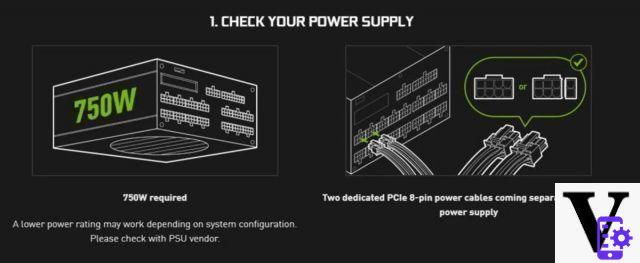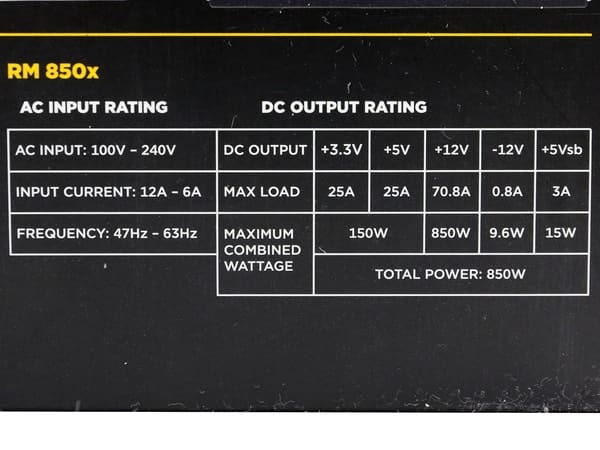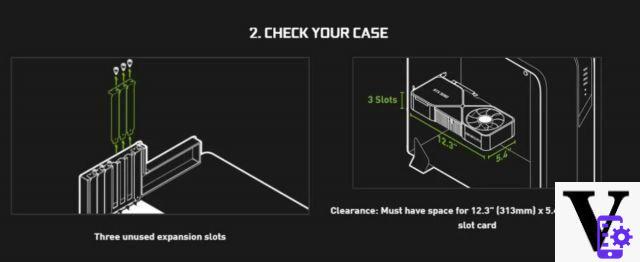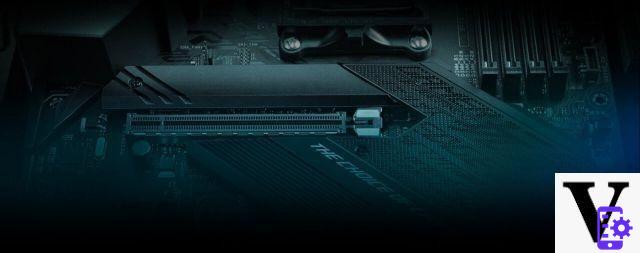Is the power supply of my PC sufficient for the new GeForce RTX 3000?
The first compatibility problem that can arise is that of the power supply. On its site, Nvidia indicates that it is necessary to have a power supply of at least 650 W for the RTX 3070 and 750 W for the RTX 3080 and the RTX 3090. Figures which quickly made the rounds of the web, but on closer inspection, Nvidia specifies that this is an indicator given with a configuration based on the Intel Core i9-10900K processor. The consumption of this processor, estimated at 125 W by Intel in TDP PL1, or up to 250W in TDP PL2, which is much higher than most processors on the market (a Ryzen 7 3700X is announced at 65 W) . We are therefore in the “worst possible scenario” imagined by Nvidia to estimate the recommended power supply. This also means that a power supply below 750 W can perfectly power the new cards from Nvidia, but not in all cases.

Nvidia recommends a 750 W power supply // Source: Nvidia
Evaluate component consumption
To know if your power supply will withstand the shock, you have to assess the consumption of your new PC by adding that of your current components with one of the new cards from Nvidia. Several sites like OuterVision offer tools to easily assess the consumption of a PC by indicating your different components.
In the absence of a tool like this, it is necessary to evaluate the consumption by hand, with a necessarily less precise calculation. It's not a method that we recommend, but it does exist. It is necessary to start by evaluating the consumption of the processor, directly related to its thermal dissipation (or TDP) which one finds on the product sheet of the chip. The name of the processor is indicated in the Windows system settings, or in the task manager. It is not a question of the maximum consumption of the processor, which rather hides behind the TDP PL2, a figure more difficult to find.
Here is an indication of the approximate consumption levels of the main components of a classic PC.
- Processor :
- Intel: 65 to 250W depending on the range
- AMD: from 65 to 280W depending on the range
- Fans: 5 W per fan
- Motherboard: 50W
- RAM : 10 W
- Storage:
- SSD: 2 - 10 W
- Hard drive: 5 - 15 W
To this must therefore be added the consumption of our new cards.
- Nvidia GeForce RTX 3070 : 220 W
- Nvidia GeForce RTX 3080 : 320 W
- Nvidia GeForce RTX 3090 : 350 W
As you can see, it is really the central processor and the graphics card which are the two main responsible for the consumption of a PC.
For example with a configuration based on a Ryzen 5 2600 (87 W) and with an RTX 3080, we end up with an estimated total consumption of around 480 W (87 + 320 + 5 + 50 + 10 + 10). This is still an approximate method, and we recommend using more precise tools like OuterVision above.
Evaluate the power offered by the power supply
To know if your diet is compatibleThere are first of all two characteristics to note, either from the label placed on the food, or from its characteristics indicated on the brand's website if you know the product reference. We first want to know the maximum power offered in watts. It's pretty straightforward, it's usually written in large letters, and it's also mentioned in the name of the product.

To go further, we can ensure that the power supply provides sufficient current on the +12 V rail, which is used in particular by the processor and the graphics card. Here on the power supply pictured, the +12 V rail provides an intensity of 70,8 A or a power of 850W (12 x 70,8 = 849,6). It is this figure that we can compare more directly to the addition of the consumption of our processor and our graphics card.
Compare the result
In our examples, we therefore have a PC whose components would consume 480 W and an 850W power supply. Our PC should therefore function correctly, with a good margin.
What about 8 or 12 pin PCI-E connectors?
Cards manufactured and marketed by Nvidia directly (Founder's Edition) use a new 12-pin power connector. Don't panic though, a 12-pin adapter to two 8-pin PCI-E connectors is included in the box. This new connector should therefore not pose any compatibility problems.
In addition, most cards released by other brands (Zotac, ROG, etc.) do not seem to use the new connector. They continue to use the two 8-pin connectors.
Is my box compatible?
Once we have cleared the complex issue of power, we must ask ourselves if the card will really be able to fit into the PC case. Here, it is quite simple since it is necessary to take the dimensions of the graphics card and measure the space in its case to know if it is compatible. The size depends on the card model you are going to choose, which may vary depending on the manufacturer of the graphics card. We have gathered here the dimensions of the cards manufactured by Nvidia:
- RTX 3070 : 242 mm x 112 mm x 2 slots
- RTX 3080 : 285 mm x 112 mm x 2 slots
- RTX 3090 : 313 mm x 138 mm x 3 slots
The sticking point is generally the length of the card (from 242 to 313 mm in our case), in particular in cases where the hard disks are placed in front of the graphics card. It is also necessary to take care to have the necessary space in height, that is to say 2 or 3 PCI-Express slots wide. This is generally the case in cases for gaming PCs.

The GeForce RTX 3090 is particularly bulky // Source: Nvidia
Is the motherboard compatible? What are the differences between PCI Express 3.0 and PCI Express 4.0?
Is there another element to be wary of to know if the new GeForce RTXs are compatible with a computer? New graphics cards use a 4.0-lane PCI Express 16 port, a relatively recent generation of PCI Express on computers (only AMD B550 and X570 motherboards handle it, the situation is more complex at Intel). However, the PCI Express protocol is backward compatible, and RTX 3000 cards can be used with motherboards using much more popular PCI Express 3.0 ports (since 6th Generation Intel Core processors, and AMD Ryzen processors).

PCI Express is backwards compatible // Source: Asus
Is it a big deal to use a new graphics card with a PCI Express 3.0 motherboard? According to Nvidia, the difference in performance will on average be of the order of only a few percentages. We will have to wait for more extensive press testing to be sure, but it does seem that it is not a problem to use an old motherboard.
That being said, in the long run, this could be problematic with the use of RTX IO in games, which allows the bandwidth of NVME SSDs connected in PCI Express to be managed, through on-the-fly decompression performed by them. graphics cards. Anyway, such a problem should not arise for several years, when game developers have fully adopted the architecture of the new consoles, and DirectStorage. What to amortize the purchase of its graphics card, and to wait before changing platform AMD or Intel.
Conclusion
Once we have checked the compatibility of its power supply, its case and its motherboard with the new graphics cards from Nvidia, you're done. This does not mean that the change will necessarily be opportune, maybe the performance in game will be limited by your processor, your storage or your RAM. We will also have to wait for press tests to verify the performance of each of these cards in many scenarios.
To follow us, we invite you to download our Android and iOS application. You will be able to read our articles, files, and watch our latest YouTube videos.


























